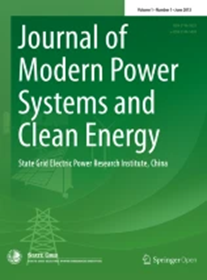大容量电力系统的降阶母线频率响应模型
IF 6.1
1区 工程技术
Q1 ENGINEERING, ELECTRICAL & ELECTRONIC
Journal of Modern Power Systems and Clean Energy
Pub Date : 2025-01-20
DOI:10.35833/MPCE.2024.000737
引用次数: 0
摘要
大容量电力系统呈现出越来越显著的频率空间分布特征(FSDCs),导致区域间频率响应差异巨大。现有的基于解析方法的等频模型已不再适用。本文建立了一个降低阶母线频率响应(BFR)模型,以保持FSDC并描述所有母线的频率响应。证明了其数学方程与质量-弹簧-阻尼系统的强迫振动是同构的,并利用振动力学中的模态分析方法和强迫解耦方法推导了BFR模型的封闭解。讨论了其数学方程与小信号稳定性分析的状态方程之间的关系,并在不附加任何设备或工具的情况下,采用本征分析方法定义了CFS中的相关参数。实例研究表明,所提出的降阶BFR模型及其CFS在保证求解速度在毫秒级的前提下,提高了求解精度,既保持了大容量电力系统的显著FSDC,又代表了不同频率模型的规范化数学描述。本文章由计算机程序翻译,如有差异,请以英文原文为准。
Reduced-Order Bus Frequency Response Model for Bulk Power Systems
Bulk power systems show increasingly significant frequency spatial distribution characteristics (FSDCs), leading to a huge difference in the frequency response between regions. Existing uniform-frequency models based on analytical methods are no longer applicable. This paper develops a reduced-order bus frequency response (BFR) model to preserve the FSDC and describe the frequency response of all buses. Its mathematical equation is proved to be isomorphic to the forced vibration of a mass-spring-damper system, and the closed-form solution (CFS) of the BFR model is derived by the modal analysis method and forced decoupling method in vibration mechanics. The correlation between its mathematical equation and the state equation for small-signal stability analysis is discussed, and related parameters in the CFS are defined by the eigen-analysis method without any additional devices or tools. Case studies show that the proposed reduced-order BFR model and its CFS can improve the solution accuracy while keeping the solution speed within milliseconds, which can preserve the significant FSDC of bulk power systems and represent a normalized mathematical description of distinct-frequency models.
求助全文
通过发布文献求助,成功后即可免费获取论文全文。
去求助
来源期刊

Journal of Modern Power Systems and Clean Energy
ENGINEERING, ELECTRICAL & ELECTRONIC-
CiteScore
12.30
自引率
14.30%
发文量
97
审稿时长
13 weeks
期刊介绍:
Journal of Modern Power Systems and Clean Energy (MPCE), commencing from June, 2013, is a newly established, peer-reviewed and quarterly published journal in English. It is the first international power engineering journal originated in mainland China. MPCE publishes original papers, short letters and review articles in the field of modern power systems with focus on smart grid technology and renewable energy integration, etc.
 求助内容:
求助内容: 应助结果提醒方式:
应助结果提醒方式:


